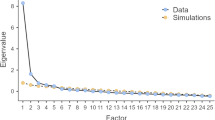Abstract
The Psychosomatic Symptom Checklist (PSC), a questionnaire assessing psychosomatic symptoms, was administered to two separate samples of college students. For Sample 1 (N=698),the questionnaire was readministered to three separate subsets at intervals of either 1 week (N=143),4 weeks (N=74),or 8 weeks (N=48).Each subset of subjects recompleted the PSC on only one of the three retest intervals. Based on the initial administration an analysis of the normative data revealed a mean total score of 23.7, suggesting a relatively low degree of psychosomatic symptoms in this group. Although total scores decreased slightly over time, test-retest correlations remained high (r>0.80, P<0.0001).Individual item correlations varied and also decreased across time; however, the majority of correlations was greater than r=0.50 throughout. Sample 2 (N=249)completed the PSC, Beck Depression Inventory (BDI), State-Trait Anxiety Inventory (STAI-X), and Rathus Assertiveness Scale (RAS), and intercorrelations were computed between these measures. This analysis revealed little overlap between the psychosomatic complaints assessed by the PSC and other commonly used measures of psychological distress. Finally, a factor analysis revealed one major factor on which all but 2 of the 17 questionnaire items loaded significantly. These results suggest that the PSC is sensitive to psychosomatic distress and remains reliable over time.
Similar content being viewed by others
References
Andrasik, F., Blanchard, E. B., Arena, J. G., Teders, S. J., Teevan, R. C., and Rodichok, L. D. (1982). Psychological functioning in headache sufferers.Psychosom. Med. 44: 171–182.
Andrasik, F., Holroyd, K. A., and Abell, T. (1979). Prevalence of headache within a college student population: A preliminary analysis.Headache 19: 384–387.
Beck, A. T., Ward, C. H., Mendelsohn, M., Mock, J., and Erbaugh, J. (1961). An inventory for measuring depression.Arch. Gen. Psychiat. 5: 561–571.
Coelho, G. V., Hamburg, D. A., and Murphey, E. B. (1976). Coping strategies in a new learning environment: A study of American college freshman. In Moos, R. H. (ed.),Human Adaptation: Coping with Life Crises, D. C. Heath, Lexington, Mass.
Cox, D. J., Freundlich, A., and Meyer, R. G. (1975). Differential effectiveness of electromyograph feedback, verbal relaxation instructions and medication placebo with tension headaches.J. Consult. Clin. Psychol. 43: 892–898.
Feldman, K. A., and Newcomb, T. M. (1969).The Impact of College on Students, Jossey-Bass, San Francisco.
Hayes, W. L. (1973).Statistics for the Social Sciences (2nd ed.), Holt, Rinehart and Winston, New York.
Holroyd, K. A., and Andrasik, F. (1978). Coping and the self-control of chronic tension headache.J. Consult. Clin. Psychol. 46: 1036–1045.
Holroyd, K. A., Andrasik, F., and Westbrook, T. (1977). Cognitive control of tension headache.Cog. Ther. Res. 1: 121–133.
Holroyd, K. A., Andrasik, F., and Noble, J. (1980). A comparison of EMG biofeedback and a credible pseudotherapy in treating tension headache.J. Behav. Med. 3: 29–39.
Nie, H., Hull, C. H., Jenkins, J. G., Steinbrenner, K., and Bent, D. H. (1975).Statistical Package for the Social Sciences (2nd ed.), McGraw-Hill, New York.
Rathus, S. A. (1973). A 30-item schedule for assessing assertive behavior.Behav. Ther. 4: 398–406.
Spielberger, C. D., Gorsuch, R. L., and Lushene, R. E. (1970).STAI Manual for the State-Trait Anxiety Inventory, Consulting Psychologists Press, Palo Alto, Calif.
Author information
Authors and Affiliations
Additional information
This reaserch was supported in part by Grants NS-15235 and NS-16891 from NINCDS.
Rights and permissions
About this article
Cite this article
Attanasio, V., Andrasik, F., Blanchard, E.B. et al. Psychometric properties of the SUNYA revision of the psychosomatic symptom checklist. J Behav Med 7, 247–257 (1984). https://doi.org/10.1007/BF00845390
Accepted:
Issue Date:
DOI: https://doi.org/10.1007/BF00845390




